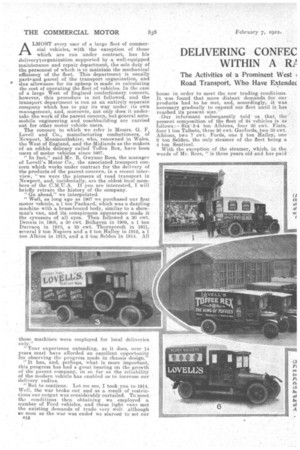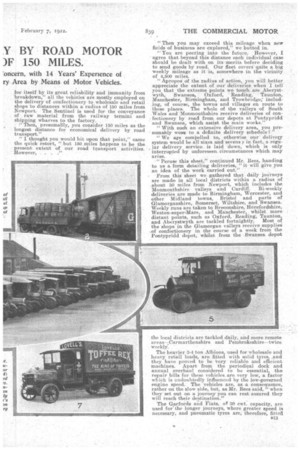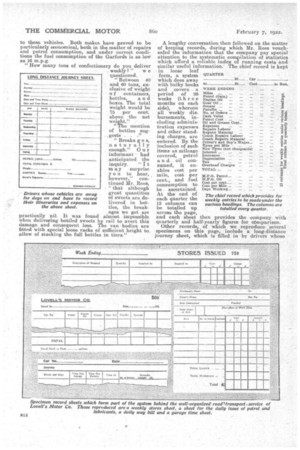DELIVERING CONFEC WITHIN A R2 Y BY ROAD MOTOR )F 150 " MILES.
Page 14

Page 15

Page 16

Page 17

If you've noticed an error in this article please click here to report it so we can fix it.
ALIVOST every user of a large fleet of commercial vehicles, with the exception of those which are run under contract, has his delivery organization supported by a. well-equipped maintenance and repair department, the sole duty of the personnel of which is to maintain the mechanical efficiency of the fleet. This department is usually parts and parcel of the transport organization, and due allowance for its upkeep is made in calculating the cost of operating the fleet of vehicles. In the case of a large West of England confectionery concern, however, this procedure is not followed, and the transport department is run as an entirely separate company which has to pay its way under its own management, and moreover, not only does it undertake the work of the parent concern, but general automobile engineering and coachbuilding are carried out for other motor vehicle users.
The concern to which we refer is Messrs. G. F. Lovell and Co., manufacturing confeetioners, of Newport, Monmouthshire, who, renowned in Wales, the West of England, and the Midlands as the makers of an edible delicacy called Toffee Rex, have been users of motor vehicles since 1907, "In fact," said Mr. R. Gwynne Rees, the manager of Lovell's Motor Co., the associated transport con, corn which works under contract for the delivery of the products of the parent concern, in a recent interview, "'we were the pioneers of road transport in Newport, and, incidentally, are the oldest local members of the C.M.T.T.A. If you are interested, I will briefly retraee the history of the company. " Go ahead," we interpolated.
"Well, as long ago as 1907 we purchased our first motor vehicle, a 1 tan Panhard, which was a dapling machine with a brass-bound body, similar to a showman's van, and its conspicuous appearance made it the cynosure of all eyes. Then followed a 30 cwt. Dennis in 1908, a 30 cwt. Belhaven. in 1909, a 1 ton Darracq in 1910., a 25 cwt. Thornycroft in 1911, fteveral 2 ton Napiers and a 2 ton Halley in 1912, a 1 ton Albion in 1913; arid a 2 ton Belden in 1914. All these machines were employed for local deliveries only."
"Your experience extending, as it does, over 14 years must have afforded an excellent opportunity for observing the progress made in chassis design.
"It has, and, perhaps, what is more important, this progress has had a great bearing on the growth of. the parent company, in so far as the reliability of the modern vehicle has enabled us to increase our delivery radius.
"But to continue. Let me see, I took you to .1914. Well, the war broke out and as a result of restrictions our output was considerably curtailed. To.meet the conditions then obtaining we employed a number of Ford vehicles, and these light vans met the existing demands of trade very welL although se soon as the war was ended' we started to set our 512 house in order to meet the new trading conditions. It was found that more distant demands for our products had to be met, and, accordingly, it was necessary gradually to expand our fleet until it has reached its present size."
Our informant subsequently told us that. the present composition of the fleet of 24 vehicles is as follows :—Six, 3-4 ton Albions, four 30 cwt. Fiats, four 1 ton Talbots, three 30 cwt. Garfords, two 30 cwt. Albions, two 7 cwt. Fords, one 2 ton Halley, one 2 ton Belden, the only steamer of the fleet being a 4 tan Sentinel.
With the exception of the steamer, which, in the words of Mr. Rees, "is three years old and has paid for itself by its great reliability and immunity from breakdown," all the vehicles are mostly employed on the delivery of confectionery to wholesale and retail shops to distances within a radius of 150 miles from Newport. The Sentinel is used for the conveyance of raw material from the railway termini and shipping wharves to the factory. . "Then, presumably, you consider 150 miles as the longest distance for economical delivery by road transport."
"I thought you would hit upon that point," came the quick retort, "but 150 miles happens to be the present extent of our road transport activities. However
"Then you may exceed this mileage when new fields of businesfr are explored," we butted in.
'You are peering into the future. However, I agree that beyond this distance each individual case should be dealt with on its merits before deciding to send goods by road. Our fleet covers quite a big weekly mileage as it is, somewhere in the vicinity of 4,500 miles.
"Apropos of the radius of action, you will better appreciate the extent of our deliveries when I tell you that the extreme points we touch are Aberystwyth, Swansea, Oxford, Reading, Taunton, Manchester, Birmingham, and Trowbridge; including, of course, the towns and villages en route to these places. The whole of the valleys of South Wales and Monmouthshire receive deliveries of confectionery by road• from our depots at Pontypridd and Swansea, which assist the main works."
'With sueh an extensive delivery area, you presumably woisx to a definite delivery schedule?"
"We ki,re compelled to, otherwise our delivery system would be all sixes and sevens ? in fact, a regular delivery service is laid down, which is only interrupted by unforeseen. circumstances which may arise.
-" Peruse this sheet," continued Mr. Rees, handing to us a form detailing deliveries, "it will give you an idea of the wotk carried out."
From this sheet we gathered that daily journeys are mad& in all local districts within a radius of about 30 miles from Newport, which includes the Monmouthshire valleys and Cardiff. Bi-weekly deliveries are made to Birmingham, Worcester, and other Midland towns, Bristol and parts of Glamorganshire, Somerset, Wiltshire, and Swansea. Weekly runs are taken to Breeonshira, Herefordshire, Weston-super-Mare, and Manehester, whilst more distant points, stich as Oxford, Reading, Taunton, and Aberystwyth arc tackled fortnightly. Most of the shops in the Glamorgan valleys receive supplies ..of confectionery in the course of a week from the Pontypridd depot, whilst from the Swansea depot the local districts are tackled daily, and more remote areasCarmarthenshire and Pembrokeshire—twice weekly.
The heavier 3-4 ton Albions, used for wholesale and heavy 'retail loads, are fitted with solid tyres, .and they have proved to be very reliable and efficient machines. Apart from the periodical dock and annual overhaul considered to be essential., the repair bills for these vehicles,are very low, a factor which is undoubtedly influenced by the low-governed engine speed. The vehicles are, as a consequence, rather on the slow side, but, as Mr. Rees said, "when they set out on a journey you can rest assured they will reach their destination."
The Garfords and Fiats, of 30 cwt. capacity, are used for' the longer journeys, where greater speed is necessary, and pneumatic tyres are, therefore, fittat B13
LONG DISTANCE JOURNEY SHEET.
to these. vehicles. Both makes have proved to be particularly economical, both in the matter of repairs and petrol consumption, and under correct conditions the fuel consumption of the Garfords is as low as 16 m.p.g.
"Hew many tons of confectionery do you deliver weekly ? " we questioned.
"Between 40 and 60 tons, exclusive of weight o f containers, bottles, a n d boxes. The total weight would be 75 per cent. above the net welt."
"The mention
of bottles sug gests . ."
" Breaka g e s, naturally enough." Our informant had anticipated the inquiry. (4 t m a y surprise y o u to hear, however," continued Mr. Rees, "that although great quantities of sweets are delivered in bottles, the breakages we get are
practically nil. It was found almost impossible when delivering bottled sweets by rail to avert this damage and consequent loss. The van bodies are fitted with special loose racks of sufficient height to allow of stacking the full bottles in tiers." A lengthy conversation then followed on the matter of keeping records, during which Mr. Rees vouchsafed the information that the company pay special attention to the systematic compilation of statistics which afford a reliable index of running costs and similar useful information. The chief record is kept in loose leaf form, a system
which does away — 19 . with bulky books to 19 Cost. to Run.
and covers a period of 2G weeks (t hree months on each side), whereon all weekly disbursements, including administration expenses and other standing charges, are entered. By the inclusion of such items as mileage covered, petrol a n d oil consumed, it enables cost per mile, cost per cent., and fuel consumption to be ascertained. At the end of each quarter the 13 columns can be totalled up across the page, and each sheet then provides the company with quarterly and half-yearly figures for etunparison.
Other records, of which we reproduce several specimens on this page, include a long-distance journey sheek which is filled in by drivers whose
WEEK ENDING
Miles ...
Petrol (Gals.) ...
Engine Oil ...
Gear Oil._ -.
Grease ... Paraffin _ No. at Orders ...
Cash Value ... Petrol Cost Oil and Grease Cost.. Expenses Repairs Labour Repairs Material Coach Repairs Labour .. Coach Repairs Material ... Driver's and Boy's-Wages... Tyres per Mile New Tyres (not chargeable)
The chief record which provides for weekly entries to be made under the various headingsThe columns are totalled every quarter.
Insurance ...
Depreciation . Tax Overhead Charges TOTAL M.P.G. Petrol...
Oil
Cost per cent.... Cost per Mile Days Working ..
vehicles are away tor days on end a weekly stores sheet, a sheet which records the daily issue of petrol and lubricants, a daily way bill made out by drivers who are engaged on daily. rounds, and a garage time sheet, which on one side gives particulars of a job going through the works, its cost for labour and maeerial, and the charge made for it, whilst on the reverse side the material used its cost, and charge are entered. Each of these records provides invaluable information, and, although the company are firm believers in the necessity for maintaining strict surveillance on every unit of the fleet, they do not uphold the need for amassing and collating of redundant or unnecessary statistics. A complex system run riot is worse than no system at all," Mr. Rees observed. "Why, I can produce at a few moments' notice particulars relating to the running. costs of any unit of the fleet."
'Then you can give us these costs for each vehicle, say, during the past half-year ? "we asked, hoping to put this bold statement to the test.
"That's an easy matter," came the cheery reply. A few minutes elapsed, and Mr. Rees continued, • running his eye over a carefully kept dossier, "Here we are. Let us take the vehicles in the order of their carrying capacities. You will observe, that the 4 ton Sentinel, on solid tyres,.costs—mind you, all these figures are for the past six months—qs. 9d. per mile 'to run, the 3-4 ton Albion s on solids is. 8d. per mile, the 30 cwt. Albions on solids It. 4d. per mile, the 30 cwt. Fiats Is. 5d. per mile, the 25-30 cwt. Garfords !1s. 4d. per mile, and the 1 ton Talbots is. 5d. per mile, the last three makes being, of course, shod -with pneumatic tyres.' "Are these inclusive figures?" we interrupted.
"Don't anticipate me. I was coming to that point. The costs I have given you are exclusive of management charges, but include all running and maintenance costs, comprehensive insurance, interest and tax. The charges for management, office burden, rates, rent, taxes etc., are based at £2 10s. per week for each vehicle./'
The maintenance of a fleet of the size employed by Messrs. Lovell's is a big item, and in connection with repairs and overhauls, which are carried out in the company's own shop, Mr. Rees has evolved his own methods of efficiency. Each vehicle is subjected to a dock overhaul about eveiy ten weeks, and this consists of taking cylinders off, decarbonizing, grinding-in valves and taking up or replacing :any worn part. The carburetter and magneto receive attention at the same time, as well as brakes, whilst all covers are removed to enable a thorough inspection of the working parts to be made. Each vehicle is stripped and completely overhauled once a year. By means of this system breakdowns on the road are exceedingly rare, and for the past year's working they could be counted on the fingers of one hand. Minor repairs and adjustments which may be found necessary from time to time are reported. by the drivers on their daily way bills. All the bodies fitted on the vehicles were built in the company's own workshops where they are also maintained. They are painted and designed to advertise forcibly the products of the company, ae some of the illustrations on the previous pages show. Great faith is placed in the advertising value of the vehicles, for the company realize that the regular appearance of smart vans on the road builds up a goodwill which is invaluable. The works are well equipped with modern machinery, including a woodeeerking machine shop, which is replete with up-to-date plant. A Hollings and Guest tyre press is installed, as well as a Harvey Frost vulcanizing plant, and the usual lathes, drills, shapers and millers are provided for metal work. An underground petrol storage installation on the Bowser principle, having a capacity of 1,000 gallons, is provided, whilst oil is also stored on the Bowser principle. It is interesting to note that the company hold agencies for a number of leading tyre makers. Apart from their own repair work, the company have a very extensive outside connection for mechanical repairs and coachbuilding.
"Let me tell you before you leave," Mr. Rees went on to say, 'that delivery by road transport has been found to act as a stimulus to trade, and that the customer greatly appreciates direct delivery of his goods. It has been proved, too, that where the railway has been superseded by .road motor the trade has been trebled in a very short space of time. Another great point in favour of the motor vehicle is that it eliminates all -packing costs and ensures that the customer will receive his goods in perfect Condition. It also does away with railway claims.
.`• I should like to say a word in conclusion on the present system of taxation. This to my mind is most unjust and inequitable, and I think shows the railway mind working in transport matters. In the ease of our company we are paying double the taxes that we did under the old scheme of paying according to the amount of petrol used. Moreover, under the new system the whole amount has to be paid, in a lump sum, whereas it was previously spread over the whole of theepetrol .purchases for the year. At present the tax has to be paid whether a, vehicle is in use or not, and if it so happens that a machine is badly damaged or eta of commission for any length of time, this represents a dead loss which has to be paid for in taxes. My opinion is that the sooner the system of the old petrol tax is reverted to, even though the amount be increased, the better for all commercial users."




























